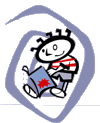 |
 |
 |
 
|
This book is aptly named. While reading through the facts on animals (which include birds, insects, fish and reptiles), I heard myself saying “Wow!” and “I didn’t know that!”
For instance, I didn’t know gorillas never sleep in the same nest for more than one night, or that crocodiles store fat in their tail and can survive up to two years without food. I did know that ostriches don’t bury their head in the sand, but I didn’t know how the misunderstanding came to be until I read the page devoted to the ostrich (who looks much cuter in Aspinall’s illustration than in real life).
This book doesn’t read like a story, but because the facts and illustrations interrelate, the information flows smoothly from page to page. After reading about lobsters, children learn about the other creatures that live in the ocean such as sharks and whales and flying fish. Some animals hide their identities, but with a turn of the page, children can see which animal was jumping across the page, or left their paw or tail peeking out from the corner.
You could easily use this book during a story time or class visit by asking the children to point to the animal they want to learn about, then choosing one or two of the four facts on the page. This also works well for a book talk with children in grades two to four.
|







|
| |
Tanya Boudreau/2013 for curled up with a good kid's book |
|
|
For grown-up fiction, nonfiction and speculative fiction book reviews,
visit our sister site Curled Up With a Good Book (www.curledup.com)
|
|